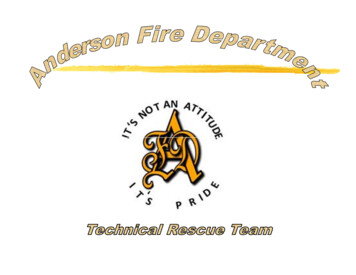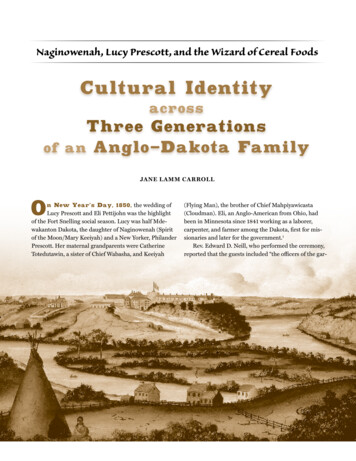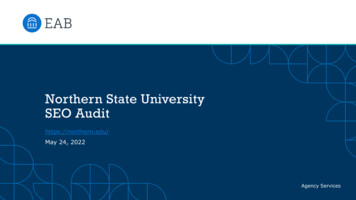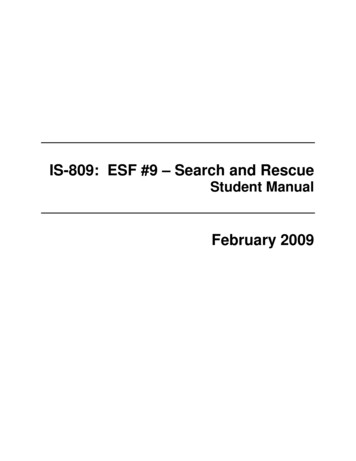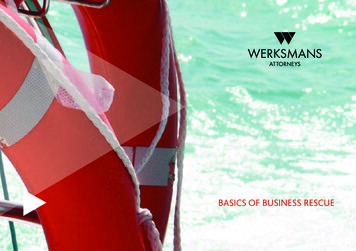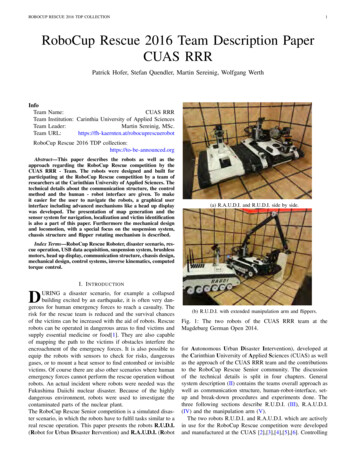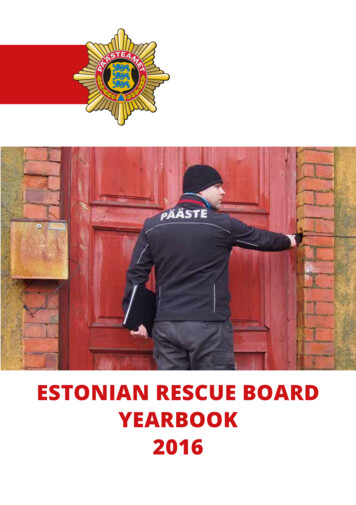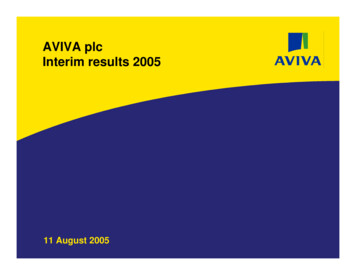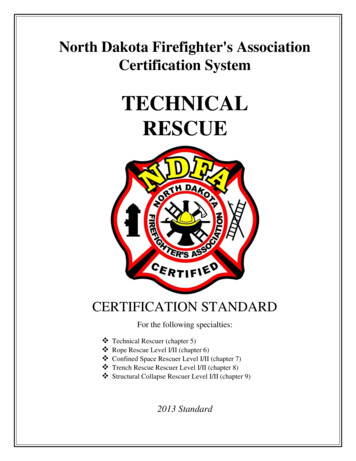
Transcription
North Dakota Firefighter's AssociationCertification SystemTECHNICALRESCUECERTIFICATION STANDARDFor the following specialties: Technical Rescuer (chapter 5)Rope Rescue Level I/II (chapter 6)Confined Space Rescuer Level I/II (chapter 7)Trench Rescue Rescuer Level I/II (chapter 8)Structural Collapse Rescuer Level I/II (chapter 9)2013 Standard
16 Firefighter Life Safety Initiatives1. Define and advocate the need for a cultural change within the fire service relating to safety;incorporating leadership, management, supervision, accountability and personal responsibility.2. Enhance the personal and organizational accountability for health and safety throughout the fireservice.3. Focus greater attention on the integration of risk management with incident management at alllevels, including strategic, tactical, and planning responsibilities.4. All firefighters must be empowered to stop unsafe practices.5. Develop and implement national standards for training, qualifications, and certification(including regular recertification) that are equally applicable to all firefighters based on the dutiesthey are expected to perform.6. Develop and implement national medical and physical fitness standards that are equallyapplicable to all firefighters, based on the duties they are expected to perform.7. Create a national research agenda and data collection system that relates to the initiatives.8. Utilize available technology wherever it can produce higher levels of health and safety.9. Thoroughly investigate all firefighter fatalities, injuries, and near misses.10.Grant programs should support the implementation of safe practices and/or mandate safepractices as an eligibility requirement.11.National standards for emergency response policies and procedures should be developed andchampioned.12.National protocols for response to violent incidents should be developed and championed.13.Firefighters and their families must have access to counseling and psychological support.14.Public education must receive more resources and be championed as a critical fire and life safetyprogram.15. Advocacy must be strengthened for the enforcement of codes and the installation of home firesprinklers.16. Safety must be a primary consideration in the design of apparatus and equipment.2
16 Firefighter Life Safety InitiativesThe 16 initiatives, listed on the preceding page, address the 6 root causes of firefighter injuries, closecalls, and Line of Duty Death.1.2.3.4.5.6.Ineffective policies and procedures.Ineffective decision making.Lack of preparedness.Ineffective leadership.Lack of personal responsibility.Extraordinary and unpredictable circumstances.For more information on theCourage to Be Safe . So Everyone Goes Home programContact NDFAAt: 701-222-27993
NDFA Firefighters Certification CommitteeThe NDFA Certification Committee is a 12-member committee, which consists of 9- members fromthe North Dakota fire service; the committee members function as liaison between the fire serviceand the North Dakota Firefighters Association Executive Board. Members of the committee are: NDFA 1st Vice President State Fire Marshal (1) A member from the North Dakota Fire Chief’s Association that will serve a 2-year term. (1) A member from the North Dakota Fire Prevention Association that will serve a 2-year term. (1) A member from the North Dakota Instructor Society that will serve a 2-year term. (4) Four NDFA members at large, one member elected from each of the 4 training regions: NW, SW,NE, and SE: (their terms will mirror the Trustee from their region). (1) A member of the Fargo Fire Department (Delegated Authority). The NDFA Training Director will serve as compliance officer and serve the Certification Committeeas a non-voting member of the committee.North Dakota Firefighter’s AssociationPlease direct North Dakota Firefighter certification questions and comments to:NDFA, Training DirectorRobert KnuthPO Box 61276909 Aurora LoopBismarck, North Dakota 58506PH: (701) 222-2799 CP: (701) 516-4457 FAX: (701) 222-2899Please visit our Web site at: www.ndfa.net4
TABLE OF CONTENTSIntroduction6Certification Requirements for Firefighter IEntrance RequirementsPhysical Fitness Requirements777Department TrainingWritten ObjectiveManipulative ObjectivesDepartment Training OfficersDepartment Training RecordsDepartment In-House Comprehensive Examination889101010Certification ExaminationsWritten ExaminationsManipulative Skills “Spot” ExaminationOperational LevelsPrerequisites for Certification1111121313SECTION I – Chapter 5Technical Rescuer (JPRs)Technical Rescuer (Training Records)1438SECTION II – Chapter 6Rope Rescuer Level I (JPRs)Rope Rescuer Level II (JPRs)Rope Rescuer Level I&II (Training Records)404958SECTION III – Chapter 7Confined Space Rescuer Level I (JPRs)Confined Space Rescuer Level II (JPRs)Confined Space Rescuer Level I&II (Training Records)606670SECTION IV – Chapter 8Trench Rescue Rescuer Level I (JPRs)Trench Rescue Rescuer Level II (JPRs)Trench Rescue Rescuer Level I&II (Training Records)728087SECTION V – Chapter 9Structural Collapse Rescuer Level I (JPRs)Structural Collapse Rescuer Level II (JPRs)Structural Collapse Rescuer Level I&II (Training Records)89103120Appendix A – IN-HOUSE PROCTOR INSTRUCTIONSAppendix B – EXAMINATION REQUEST FORMAppendix C – CANDIDATE ACKNOWLEDGEMENT FORM1221241275
INTRODUCTIONThe world we live in is changing so fast, and the many phases of the fire service are becoming sotechnical and complex that fire service training must be utilized to its maximum potential. Anyoverlap, fragmentation, and lack of basic structure must be eliminated. Standardization is thenatural complement and necessity.The fire service in North Dakota, through a state certification program, can meet the needs of futuregrowth and establish uniformity through certification. We will then have more effective andefficient utilization of resources so as to provide the best possible fire protection service for all thecitizens throughout the state of North Dakota.The following certification requirements are based on the objectives listed in the National FireProtection Association (NFPA) 1006 standard for Technical Rescuer Professional Qualifications,2013 Edition, Chapters 5, 6, 7, 8, & 9 as verified and adopted by the NDFA Certification Committee.Through these national standards and certification, firefighters and fire departments have a tool tomeasure specific levels of skills, abilities and knowledge. The NDFA Firefighters CertificationCommittee believe by participating in this certification program, firefighters and fire departmentswill be better prepared to provide quality life safety and fire protection for their communities.6
CERTIFICATION REQUIREMENTSEntrance Requirements:Certification as a Technical Rescuer is a unique process. Qualification is specific to a specialty area. Forqualification, a rescuer shall receive and complete training on the job performance requirements inChapter 5 and Chapter 6.1 (Rope Rescuer – Level I). This is the prerequisite for all job performancerequirements listed in all offered specialty areas (chapters 6.2 through 9). Technical rescuers will be identified bytheir specialty area and level of qualification (i.e., Rope Rescuer — Level I, Confined Space Rescuer—Level II,etc.).Rescuers must:a. Receive and complete a Department Training Record for the Technical specialty area.b. Pass an "In House" practical skills examination.c. Meet any other training requirements/prerequisites as defined by the Certification Committee.d. Pass both written and practical skills Certification examination administered by evaluators appointedby the Certification Committee.e. Request Technical Rescue Certification for the specialty area completed.The NDFA acknowledges the importance of and need for entrance requirements as listed in the NFPA1001, Standard on Fire Fighter Professional Qualifications. Many agencies and departments haveexisting policies, regulations, etc. already in place regarding these requirements. The handling ofentrance requirements is a LOCAL MATTER, outside the authority and jurisdiction of the NDFA.The NDFA will not check, test, evaluate or determine how individual agencies meet theserequirements. Some departments have found it necessary to waive any type of entrance requirementsdue to their own special needs. As a local decision, this is permitted. However, due to the amount ofphysical, mental and emotional stress inherent in this profession, the NDFA strongly recommendscareful evaluation before altering or doing away with any existing entrance requirements.Physical Fitness Requirements:The requirements listed in NFPA 1001, Chapter 4 are:1. Meet the minimum educational requirements established by the authority having jurisdiction.2. Meet the medical requirements of NFPA 1582, Standard on Comprehensive OccupationalMedical Program for Fire Departments.3. Physical fitness requirements for entry-level personnel shall be developed and validated by theauthority having jurisdiction. Physical fitness requirements shall be in compliance withapplicable Equal Employment Opportunity regulations and other legal requirements.7
DEPARTMENT TRAININGThe position of a Technical Rescuer is one that requires a high level of skill and knowledge. The training thatis given to and received by the candidate should be of the highest quality and degree. All training receivedmust meet the requirements of NFPA 1006 Chapter 5 and at least one specialty area (chapters 6-9, 2013edition) and the skills as approved by the Certification Committee contained within the NDFA Standard. Alltraining received must be documented and recorded in the Training Record. All testing for Technical Rescuewill be conducted following the Policies and Procedures of the NDFA.Training for Technical Rescue can be obtained by completing one of the following training courses ormethods to qualify to take the state Certification examination. Technical Rescue course in one of the following Technical Specialty areas: Ropes, Confined Space,Trench, Structural Collapse. A Training Record as given in this standard must be completed for eachperson. Department Based Training – Departments can create their own Technical Rescue course whichmeets the requirements as outlined in NFPA 1006 Chapter 5, plus the chapter containing theTechnical Specialty areas contained in Chapter 6 -9, 2013 edition). A Training Record as given in thisstandard must be completed for each person involved in the department-based training.The course material should be referenced to the following textbook to prepare the candidate tosuccessfully pass the state certification examination.Written Objectives:The course material should be referenced to the following textbook(s) to prepare the candidate to successfullypass the State Certification examination.Written objectives for Technical Rescue are covered in the following texts for each of the specialty areas:Chapter 6, Rope Rescue: Jones & Bartlett, High Angle Rope Rescue Techniques, Levels I and II, 4th Ed.Chapter 7, Structural Collapse Rescue: FEMA National US & R Response System, Structural Collapse Technician; and Jones and Bartlett, Brannigan’s Building Construction for the Fire Service, 4th Edition J&B Learning, Emergency Medical Responder, 5th EditionChapter 8, Confined Space Rescue: CMC, Confined Space Entry and Rescue, Revised 2nd Ed; and J&B Learning, Emergency Medical Responder, 5th EditionChapter 9, Trench Rescue: Jones & Bartlett, Trench Rescue Principles and Practice to NFPA 1006 and 1670, 3rd Edition8
Manipulative Objectives:There are numerous methods departments have used to help prepare their personnel for the writtenexamination. Considering the elevated level of skill and knowledge that is required of a Rescue Technician,the Certification Committee recommends that the candidate participate in a comprehensive class and receiveinstruction on both manipulative skills and written requirementsEach participant must be trained and evaluated in the performance of all-manipulative skills as found in thiscertification standard.Each of the manipulative skill objectives shall be completed swiftly, safely and with competence as definedbelow: Swiftly – Each manipulative skill objective must be completed within the allotted time. Safely – Each manipulative skill objective must be completed safely. Actions that could injureindividual or damage equipment are unacceptable. Equipment should be checked prior to skill testingor training to see that it is safe and functional. Competence – Each manipulative skill objective is performed in accordance with the North DakotaStandard. This includes performing the proper steps as outlined in the respective JPR skill sheet.Competence will be measured in accordance with the NDFA manipulative skill objectives.9
Department Training Officers:For departments to enroll in the certification process, it is necessary for the department to assigntraining officers. It is recommended the department assign at least two personnel as trainingofficers to coordinate and provide certification training.Department training officers should be State Certified at the level they are teaching. In addition, theNDFA strongly recommends training officers be state certified at the Instructor I level.Department training officers will be responsible for certification training. Their primaryresponsibility will be to teach, evaluate, and “In-House” test department personnel on themanipulative skill and evolution requirements for each level of certification training.Departments who do not have certified personnel to act as training officers for certification trainingshould contact the NDFA-Training Director at (701) 222-2799 for assistance in setting up andmonitoring certification training.Department Training Records:Each candidate shall have a training record on file with the department, which indicates whetherhe/she has trained on all manipulative skill objectives. This record shall be signed off or initialedby a department training officer. Training records must indicate the date, instructor, and totalnumber of hours trained for each manipulative skill objective. Departments shall use the oneprovided at the end of the section correlating to the standard for which he/she is attempting.Department "In-House" Comprehensive Examination:At the completion of the department’s manipulative skills training, the department is required tohold an “in-house” comprehensive examination for the level being trained. This is a comprehensive“In-House” test conducted by the department training officers or course instructors. This test is toensure that skill mastery has been obtained from the beginning to the end of the training process,and to prepare participants for the state examination. Training officers may utilize other personnelto assist in administering the exam; however, all personnel assisting with the testing should becertified at the level they are “In-House” testing.In-House testers shall follow the Tester Instruction sheet to provide for uniformity and fairnessduring the exam. It is recommended candidates be given two attempts at any skill. If they fail onthe second try, then they have failed the evaluation and are required to go through additionaltraining by the department trainer. No training, teaching, or coaching is allowed during the test.After the evaluation, using the test to teach and train is recommended.If manipulative skill weaknesses are evident, the department shall conduct additional training andhold a new department “In-House” comprehensive examination. Only those candidates whosuccessfully pass the department’s skills and fire ground evolutions “In-House” test will be allowedto participate in the state certification exam. Department training records must show all candidateshave successfully passed the “In-House” examination.10
CERTIFICATION EXAMINATIONSAfter completion of the training process, the Fire Chief/Head of Department can request testing forthe department. Using the “Request Examination” form in Appendix B. The Fire Chief/Head ofDepartment may request a written examination and manipulative test for certification. A testing feemay be charged at the time of certification. A separate application must be sent to the NDFA foreach attempt. Request forms must reach the NDFA no later than 30 days prior to the examinationdate. The entire examination process must be completed within 1 year of the first written examdate.Written Examinations:The written examinations are randomly generated, 20-30 question per level, tests covering thewritten objectives of the Technical Rescue standard of NFPA 1006 (2013 ed.) in Chapters 5, 6, 7,8, & 9. A minimum score of 70% is required to pass the certification exam. Candidates failing thefirst attempt of the written exam will be permitted to retest no sooner than 30 days from the dateof the last exam. Three attempts are given to pass the exam. If a participant fails the writtenexamination three times, he/she has failed the certification process and must wait 1 year from thedate of the last failed exam before re-entering the testing process. Exam results are forwarded tothe Chief/Administrator within 30 days following the receipt of the completed Exam.11
Manipulative Skills “Spot Check” Examination:This is a two-step examination. A department record check and the manipulative skills "spot check"examination. A certification tester appointed by the NDFA Certification Advisory Committeeconducts the examination.Training records are checked. If records are inadequate, corrective action must be taken beforeproceeding to the next step. The records must meet minimum requirements and are checked for thefollowing: Participant has been trained in each manipulative skill for the level being evaluated.A department training officer has signed off each manipulative skill.Each trainee has passed a department "in-house" manipulative skills examination.The manipulative skill "spot check" examination is graded on a 100% pass/fail basis. The test isgraded in the following three areas:Swiftly - Each manipulative skill objective must be completed within the allotted time.Safely - Each manipulative skill objective must be completed safely. Conduct that could injure anindividual or damage equipment is unacceptable. Equipment should be checked prior to skill testingor training to see that it is safe and functional.Competence - Each manipulative skill objective is performed in accordance with the UtahStandard. This includes performing the proper steps in sequence. Competence will be measured inaccordance with the UFSCS manipulative skill objectives.Participants are "spot checked" on three manipulative skills, or one scenario depending upon thelevel. The skills will be from NFPA 1006 (2013 ed.) Chapter 5 and the Technical Specialty areasin which the candidate has received training as contained in Chapter 6, 7, 8, or 9. No priornotification of which skill being tested will be given. Participants are given two attempts initially(if necessary) to perform each skill. If they fail on the second attempt, the applicants must wait 30days before the third and final attempt. Participants taking third attempts will test on the skill theymissed plus an additional skill from the section of the standard they failed during the previous twoattempts. No training, teaching, or coaching is allowed during the state test.Participants who have failed the third attempt of the written examination or the manipulative skillsexamination have failed the certification process and must wait 1 year from the date of the failedthird attempt to re-enter state testing. The participant will begin testing with a new 1st attempt ofthe written examination.When all requirements for certification have been met, applicants are eligible to be certified. TheChief/Administrator may apply to the North Dakota Firefighter’s Association for certification forthose participants who have successfully completed the certification training/testing process.Request for state certification will be submitted to the NDFA using the "Request for Certification"form provided in Appendix C. The names are then checked against the official state records toensure that everyone listed has met all requirements and prerequisites.12
Operational Levels.The AHJ shall establish written standard operating procedures (SOPs) consistent with one of the followingoperational levels for each of the disciplines defined in this document:a. Level I. This level shall apply to individuals who identify hazards, use equipment, and apply limitedtechniques specified in this standard to perform technical rescue operations.b. Level II. This level shall apply to individuals who identify hazards, use equipment, and apply advancedtechniques specified in this standard to perform technical rescue operations.TECHNICAL RESCUER CERTIFICATION PREREQUISITES:Standard1006Edition2013LevelRope Rescue Level IRope Rescue Level IIPrerequisitesSections 5.2 through 5.5Section 6.1Confined Space Level IConfined Space Level IISections 5.2 through 5.5Section 7.1Trench Rescue Level ITrench Rescue Level IISections 5.2 through 5.5Section 8.1Structural Collapse Level IStructural Collapse Level IISections 5.2 through 5.5Section 9.113
SECTION – ICHAPTER 5 – TECHNICAL RESCUERJOB PERFORMANCE REQUIREMENTS14
Technical Rescuer Skills AssessmentSkill Sheet #1IDENTIFY NEEDED SUPPORT RESOURCESJPR:NFPA 1006-2013 edition, Section 5.2.1Reference:High-Angle Rope Rescue Techniques: Levels I and II, 4th EditionCandidate Equipment Required: Proper PPE, applicable reference material, and portable radioEvaluator Equipment Required: Proper PPERead to Candidate:For this skill event, you will identify the needed support resources, given a specific type of rescue incident, so that aresource cache is managed, scene lighting is provided for the tasks to be undertaken, environmental concerns aremanaged, personnel rehabilitation is facilitated, and the support operation facilitates rescue operational objectives.This is not a timed event. To pass this station, you must successfully complete 100% of the skill steps.P-Pass / F-Fail1st Attempt 2nd attempt1. Resource cache is managed and tracked2. Scene lighting is provided for the tasks to be undertaken3. Environmental concerns are managed4. Personnel rehab is facilitated5. Personnel rotations are managed6. The support operation facilitates rescue operational objectivesCandidate’s Name: Station: P F1st AttemptP F2nd attemptEvaluator’s Signature:15
Technical Rescuer Skills AssessmentSkill Sheet #2SIZE UP A RESCUE INCIDENTJPR:NFPA 1006-2013 edition, Section 5.2.2Reference:High-Angle Rope Rescue Techniques: Levels I and II, 4th EditionCandidate Equipment Required: Proper PPE, applicable reference material, and portable radioEvaluator Equipment Required: Proper PPERead to Candidate:For this skill event, you will size up a rescue incident, given background information and applicable referencematerials, so that the type of rescue is determined, the number of victims is identified, the last reported location ofall victims is established, witnesses and reporting parties are identified and interviewed, resource needs are assessed,search parameters are identified, and information required to develop an incident action plan is obtained.This is not a timed event. To pass this station, you must successfully complete 100% of the skill steps.P-Pass / F-Fail1st Attempt 2nd attempt1. Type of rescue is determined2. Number of victims and last reported location of all victims is established3. Witnesses and reporting parties are identified and interviewed4. Resource needs are assessed5. Search parameters are identified6. Information required to develop an incident action plan is obtained and provided to IncidentCommandCandidate’s Name: Station: P F1st AttemptP F2nd attemptEvaluator’s Signature:16
Technical Rescuer Skills AssessmentSkill Sheet #3MANAGE INCIDENT HAZARDSJPR:NFPA 1006-2013 edition, Section 5.2.3Reference:High-Angle Rope Rescue Techniques: Levels I and II, 4th EditionCandidate Equipment Required: Proper PPE, applicable reference material, portable radio, and equipmentpertinent to a rescueEvaluator Equipment Required: Proper PPERead to Candidate: For this skill event, you will manage incident hazards, given scene control barriers, personalprotective equipment, requisite equipment, and available specialized resources, so that all hazards are identified, resource application fits the operational requirements, hazard isolation is considered, risks to rescuers and victims areminimized, and rescue time constraints are taken into account.This is not a timed event. To pass this station, you must successfully complete 100% of the skill steps.P-Pass / F-Fail1st Attempt 2nd attempt1. All hazards are identified2. Resource applications fit the operational requirements3. Hazards were isolated to minimize risk to rescuers and victims4. Rescue time constraints were taken into accountCandidate’s Name: Station: P F1st AttemptP F2nd attemptEvaluator’s Signature:17
Technical Rescuer Skills AssessmentSkill Sheet #4MANGE RESOURCES IN A RESCUE INCIDENTJPR:NFPA 1006-2013 edition, Section 5.2.4Reference:High-Angle Rope Rescue Techniques: Levels I and II, 4th EditionCandidate Equipment Required: Proper PPE, applicable reference material, portable radio, and equipmentpertinent to a rescueEvaluator Equipment Required: Proper PPERead to Candidate: For this skill event, you will manage resources in a rescue incident, given incidentinformation, a means of communication, resources, tactical worksheets, personnel accountability protocol,applicable references, and standard operating procedures, so that references are utilized, personnel are accounted for,deployed resources achieve desired objectives, incident actions are documented, rescue efforts are coordinated, thecommand structure is established, task assignments are communicated and monitored, and actions are consistentwith applicable regulations.This is not a timed event. To pass this station, you must successfully complete 100% of the skill steps.P-Pass / F-Fail1st Attempt 2nd attempt1. References are utilized2. Incident management system used3. Completes tactical worksheets4. Evaluates incident information5. Uses correct resources for operational needs6. Manages and operates communication equipment7. Communicates effectively so that objectives are metCandidate’s Name: Station: P F1st AttemptP F2nd attemptEvaluator’s Signature:18
Technical Rescuer Skills AssessmentSkill Sheet #5INITIATE A DISCIPLINE SPECIFIC SEARCHJPR:NFPA 1006-2013 edition, Section 5.2.5Reference:High-Angle Rope Rescue Techniques: Levels I and II, 4th EditionCandidate Equipment Required: Proper PPE, applicable reference material, portable radio, and equipmentpertinent to a searchEvaluator Equipment Required: Proper PPERead to Candidate:For this skill event, you will initiate a discipline-specific search, given hazard-specific PPE, equipment pertinent tosearch mission, an incident location, and victim investigative information, so that search parameters are established;the victim profile is established; the entry and exit of all people either involved in the search or already within thesearch area are questioned and the information is updated and relayed to command; the personnel assignments matchtheir expertise; all victims are located as quickly as possible; applicable technical rescue concerns are managed; risksto searchers are minimized; and all searchers are accounted for.This is not a timed event. To pass this station, you must successfully complete 100% of the skill steps.P-Pass / F-Fail1st Attempt 2nd attempt1. Search parameters are established2. Victim profile is established3. The entry and exit of all people either involved in the search or already withinthe search area are questioned and the information is relayed to command4. Personnel assignments match their expertise5. All victims are located as quickly as possible6. Applicable technical rescue concerns are managed7. Risks to searchers are minimized8. All searchers are accounted forCandidate’s Name: Station: P F1st AttemptP F2nd attemptEvaluator’s Signature:19
Technical Rescuer Skills AssessmentSkill Sheet #6PERFORM GROUND SUPPORT ACTIVITIES FOR HELICOPTER OPERATIONSJPR:NFPA 1006-2013 edition, Section 5.2.6Reference:High-Angle Rope Rescue Techniques: Levels I and II, 4th EditionCandidate Equipment Required: Proper PPE, portable radio, and requisite equipmentEvaluator Equipment Required: Proper PPERead to Candidate:For this skill event, you will perform ground support operations for helicopter activities, given a rescuescenario/incident, helicopter, operational plans, PPE, requisite equipment, and available specialized resources, sothat rescue personnel are aware of the operational characteristics of the aircraft and demonstrate operationalproficiency in establishing and securing landing zones and communicating with aircraft personnel until theassignment is complete.This is not a timed event. To pass this station, you must successfully complete 100% of the skill steps.P-Pass / F-Fail1st Attempt 2nd attempt1. Rescue personnel are aware of the operational characteristics of the aircraft2. Rescue personnel demonstrate operational proficiency in establishing andsecuring landing zones3. Rescue personnel communicate with the aircraft personnel until assignmentis completeCandidate’s Name: Station: P F1st AttemptP F2nd attemptEvaluator’s Signature:20
Technical Rescuer Skills AssessmentSkill Sheet #7TERMINATE A TECHNICAL RESCUE OPERATIONJPR:NFPA 1006-2013 edition, Section 5.2.7Reference:High
Confined Space Rescuer Level I&II (Training Records) 70 . CMC, Confined Space Entry and Rescue, Revised 2nd Ed; and J&B Learning, Emergency Medical Responder, 5th Edition Chapter 9, Trench Rescue: Jones & Bartlett, Trench Rescue Principles and Practice to NFPA 1006 and 1670, 3rd Edition . 9 Manipulative Objectives: There are numerous methods departments have used to help prepare their .
